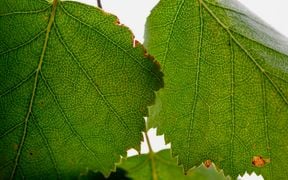Creating solar cells and glass from wood – or a billion tons of biowaste

A digital, urbanised world consumes huge amounts of raw materials that could hardly be called environmentally friendly. One promising solution may be found in renewable raw materials, according to research published in Advanced Materials. In their paper, the international research group has taken a close look at how lignocellulose — or plant biomass — can be used for optical applications, potentially replacing commonly used materials like sand and plastics.
‘We wanted to map out as comprehensively as possible how lignocellulose could replace the unrenewable resources found in widely used technology, like smart devices or solar cells,’ says Jaana Vapaavuori, assistant professor of functional materials at Aalto University, who carried out the analysis with colleagues at the University of Turku, RISE – Research Institute of Sweden, and University of British Columbia.
Lignocellulose, the term that encompasses cellulose, hemicellulose and lignin, is found in nearly every plant on Earth. When scientists break it down into very small parts and put it back together, they can create totally new, usable materials.
In their extensive review of the field, the researchers assessed the various manufacturing processes and characteristics needed for optical applications, for example, transparency, reflectiveness, UV-light filtering, as well as structural colours.
‘Through combining properties of lignocellulose, we could create light-reactive surfaces for windows or materials that react to certain chemicals or steam. We could even make UV protectors that soak up radiation, acting like a sunblock on surfaces,’ explains Vapaavuori.
‘We can actually add functionalities to lignocellulose and customise it more easily than glass. For instance, if we could replace the glass in solar cells with lignocellulose, we could improve light absorption and achieve better operating efficiency,’ says Kati Miettunen, professor of materials engineering at the University of Turku.

Unused potential
Because forest biomass is already in high demand and vast carbon sinks are crucial to the health of the planet, as a source of lignocellulose the researchers point to what’s not being used: more than a billion tons of biomass waste created by industry and agriculture each year.
‘There is massive untapped potential in the leftovers of lignocellulose from other industries,’ Vapaavuori emphasises.
For now, researchers are still studying bio-based materials and creating prototypes. At Aalto University, for example, scientists have developed light fibres and light-reactive fabrics.
Vapaavuori says that the leap to scaling-up and commercialisation could be achieved in two ways.
‘Either we create new uses for bio-based waste through government regulations or research brings about such cool demos and breakthroughs that it drives demand for renewable alternatives for optical applications. We believe that we need both political direction and solid research.’
A major obstacle in the development and commercialisation of lignocellulose-based innovations has been its manufacturing cost. Eyes were on nanocellulose already at the beginning of the 2000s but it’s only now that the energy consumption and cost of production have dropped enough to make industrial use possible. Another ongoing challenge lies in a simple but fundamental ingredient of processing: water.
‘Cellulose loves water. To use it in optical applications, we need to find a way make it stable in humid conditions,’ says Vapaavuori.

Plant-based Structures as an Opportunity to Engineer Optical Functions in next-generation Light Management
Link to the article (onlinelibrary.wiley.com)
More information:
Assistant Professor Jaana Vapaavuori
Aalto University
+358 50 476 0223
[email protected]
Professor Kati Miettunen
University of Turku
+358 40 544 8742
[email protected]
FinnCERES - Flagship for boosting bioeconomy
Boosting the world’s bioeconomy by developing new bio-based materials with Aalto University and VTT, companies, and research organizations through a shared passion to create a sustainable future and a belief in innovations based on solid scientific foundations.

- Published:
- Updated:
Read more news

From space technology and shimmering wood to shapeshifting textiles – explore world-changing research in the brand new Marsio building
The Makers of the Impossible exhibition and the Designs for a Cooler Planet festival will kick off the autumn season at Marsio – Aalto University’s brand new, open-to-all campus venue.
Transforming interdisciplinary education: Sustainable Global Technologies (SGT) across four continents
The true impact of our actions often unfolds over time, as demonstrated by the students at the SGT FAIR’24 on May 22. Their work showcased how a single student challenge can drive significant change.
CEST researchers receive significant LUMI supercomputing resources
Read how two successful machine learning projects got support by a supercomputer